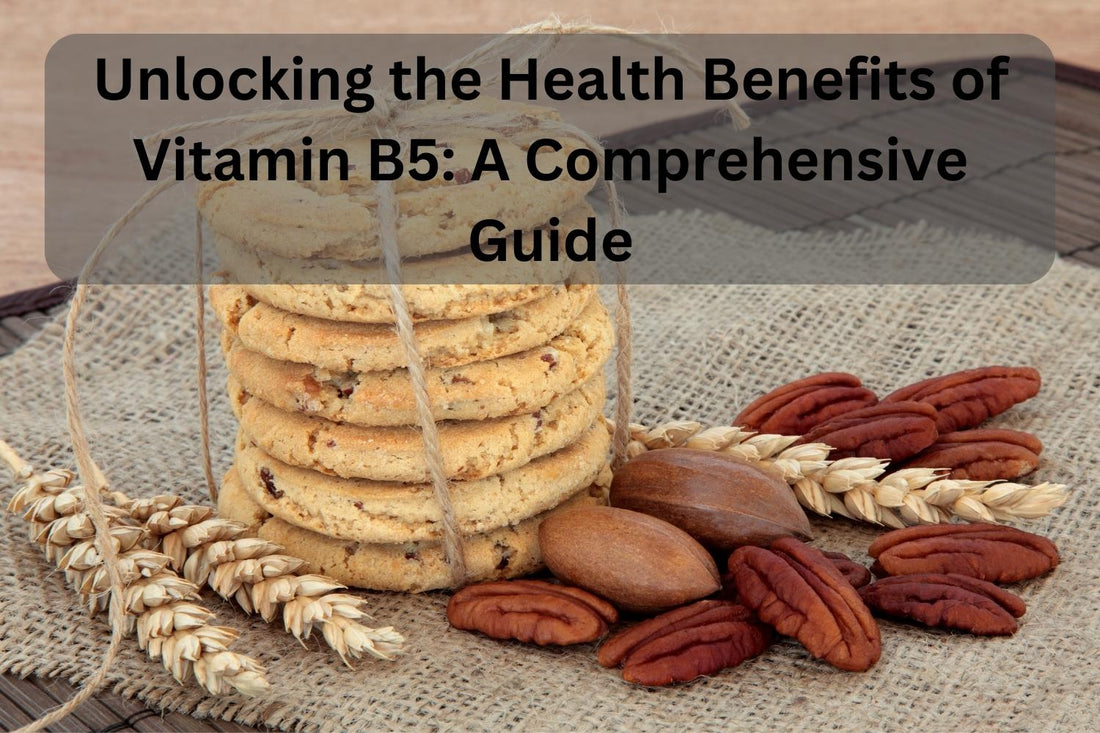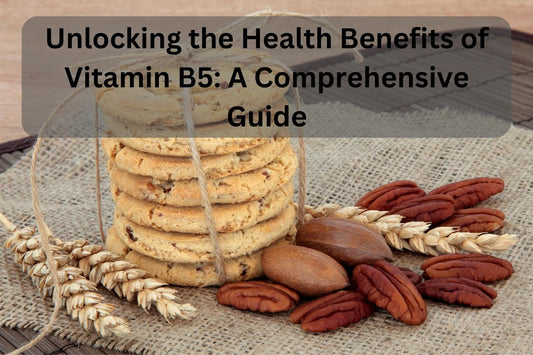Vitamin b5 benefits
-
Energy Booster: Vitamin B5 is a key part of a molecule called coenzyme A (CoA) that helps turn the food we eat into the energy our body needs. It breaks down carbohydrates, fats, and proteins to provide us with energy for all our body functions.
-
Healthy Skin Support: Vitamin B5 is often used in skincare products because it helps create fatty acids and keeps the skin hydrated. It's great for people with dry or irritated skin.
-
Wound Healing: Vitamin B5 can assist in the healing of wounds and small injuries. It helps produce the proteins needed to repair tissues and form new skin cells.
-
Adrenal Gland Function: Vitamin B5 is essential for the adrenal glands, which make hormones like cortisol. These hormones help us manage stress and keep our overall health in check.
-
Cholesterol Control: Vitamin B5 may help regulate cholesterol levels in our body. It helps break down fats, which can contribute to healthier cholesterol levels.
-
Red Blood Cell Production: Vitamin B5 is crucial for making hemoglobin, the protein in red blood cells that carries oxygen around our body. Having enough Vitamin B5 can prevent anemia.
-
Brain Function: Vitamin B5 plays a role in making neurotransmitters, which are chemicals that help our nerve cells in the brain communicate. This can affect our mood and how well we think.
-
Digestive Support: Vitamin B5 is needed to create certain compounds that help with digestion. It keeps our digestive system healthy.
-
Hair Health: Some hair products contain Vitamin B5 because it's thought to make hair stronger and protect it from damage.
-
Stress Management: While it doesn't directly relieve stress, Vitamin B5 supports our adrenal glands, which play a role in how our body deals with stress.
How much vitamin B5 per day?
Vitamin B5 is thought to be secure. Doses that are higher than the recommended dosage may cause mild diarrhea or stomach discomfort. Hypersensitivity, allergic reactions and a variety of other adverse effects may be experienced when using the vitamin B5 derivatives.
The Daily Recommendation for Intake Vitamin B5
Consume with food if given orally
-
Ages 19 and over: Men and women years of age and older 5 mg/day
-
Pregnant women are allowed to take 6 mg/day
-
Women who are lactating Women who lactate: 7 mg/day
-
Kids under 6 months: 1.7 mg/day
-
Kids aged 7-12 months 1.8 mg/day
-
Children aged 1 to 3 years 2 mg/day
-
Children aged 4-8 years 3 mg/day
-
Children aged 9-13 years 4 mg/day
-
Children aged 14-18 years 5 mg/day
Common Side Effects of Vitamin B5
As stated previously As previously mentioned, Vitamin B5 is considered to be generally as safe. There are no current upper thresholds set as there haven't been any studies of vitamin B5 toxicities in humans who have excessive intakes. There are however adverse effects associated with the use of this medication that comprise the following (these lists aren't exhaustive):
Most Common Affects
-
Muscle pain
-
Joint pain
-
Diabetes mellitus, new-onset
-
Sore throat
-
Headache
-
Lack of energy or weakness
-
Dizziness
-
Creatine Phosphorkinase (CPK) is up
-
Nausea
-
Abdominal pain
-
Transaminase Alanine (ALT) is up
-
Constipation
-
Flulike illness
-
Urinary tract infection (UTI)
-
Hypersensitivity reactions (including itching, rash, swelling, and hives)
-
Pancreatitis
More Commonly Known Side Effects
-
Eyes and skin becoming yellow (jaundice)
-
Muscle disease
-
The loss of muscle (rhabdomyolysis)
Vitamin b5 foods
Most plant- and animal-based food items have pantothenic acid in various quantities. The most nutritious diet sources include chicken, beef organ meats, organ meats, whole grains, as well as some vegetables. Pantothenic acid is a component of diverse foods, such as breakfast cereals and drinks (such in the energy drink).

Vitamin B5 chemical/scientific name
Pantothenic acid
Vitamin b5 structure
- It consists of a 2,4-dihydroxy-3,3-dimethylbutyric acid structure.
- The chemical formula is C9H17NO5.
- The molecule contains a central amide (CONH2) group, which is connected to a pantoic acid moiety.
Vitamin b5 deficiency
Vitamin B5 deficiency is also referred to in the form of pantothenic acid deficiencies, is when the body doesn't get enough Vitamin B5. Vitamin B5 is vital for a variety of biological functions and deficiency could result in a myriad of health issues. The most common signs and symptoms that are indicative of Vitamin B5 deficiency are:
-
Tiredness: Vitamin B5 can be found in creation of energy from food sources, and a deficiency may cause fatigue, and a decrease in energy levels.
-
Skin problems: Skin-related issues such as itching, dryness and various types of dermatitis can be present.
-
Gastrointestinal Issues: A lack of nutrient may cause digestive issues like abdominal pain, nausea and vomiting.
-
Muscle Cramps: Vitamin B5 is vital to maintain proper muscle function and its absence can cause muscle cramps and weakness.
-
Nerve Disorders: Certain people may feel numbness or burning sensations in their extremities.
-
Insomnia: Sleep disturbances, and difficulty in falling asleep can occur.
-
Cognitive Problems: Memory issues and trouble concentration has been linked to Vitamin B5 deficits in certain instances.




